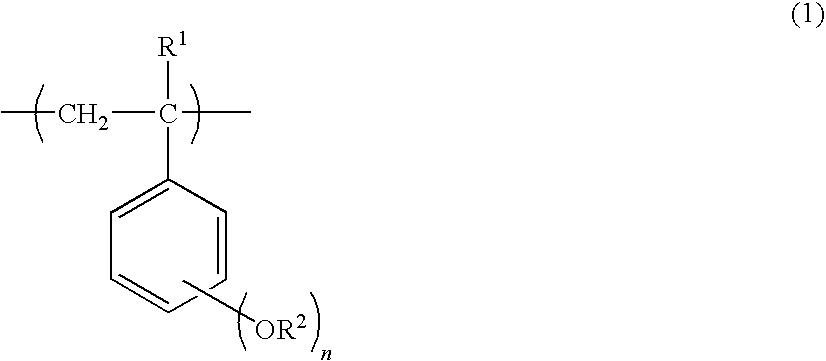Aba triblock copolymer and process for producing the same
a triblock and copolymer technology, applied in the field of new products, can solve the problems of insufficient thermal shock resistance, inability to raise the ratio of segments, and difficulty in obtaining copolymers of oxystyrene-series monomers and vinyl ether-series monomers, etc., to achieve excellent adhesion to substrates, simplify production steps, and great solubility
- Summary
- Abstract
- Description
- Claims
- Application Information
AI Technical Summary
Problems solved by technology
Method used
Image
Examples
example 1
Production of P-Tert-Butoxystyrene / Ethyl Vinyl Ether / P-Tert-Butoxystyrene-Series Triblock Polymer
[0048]A glass container with a three way valve was prepared; after the inside of the glass container was substituted with argon, the glass container was heated in argon atmosphere to remove the water adsorbed to the inside of the glass container. 0.85 mole (abbreviated as “M” hereinafter) of ethyl vinyl ether (referred to as “EVE” hereinafter), 1.0 M of ethyl acetate, 4 millimoles (abbreviated as “mM” hereinafter) of 1,4-bis(1-acetoxyethoxy)butane, and 60 ml of toluene were placed in the container, and just when the temperature of the system reached 0° C., a toluene solution (20 mM) of Et1.5AlCl1.5 was added to the glass container to initiate the polymerization.
[0049]The EVE conversion ratio was monitored by gas chromatography (GC) periodically over time. On completion of the conversion of the EVE monomer, 1.28 M of p-tert-butoxystyrene (referred to as “PTBOS” hereinafter) were added to ...
example 2
Production of P-Hydroxystyrene / Ethyl Vinyl Ether / P-Hydroxystyrene-Series Triblock Polymer (Via Deprotection of the PTBOS / EVE / PTBOS-Series Triblock Polymer)
[0052]100 parts by mass of the PTBOS / EVE / PTBOS-series triblock polymer obtained in Example 1 and 300 parts by mass of propylene glycol monomethyl ether were placed in a four-necked flask with a thermometer and a reflux condenser and heated to 60° C. under agitation; subsequently, 3.5 parts by mass of 10% sulfuric acid were added in the flask for agitation at 60° C. for 30 hours.
[0053]After completion of the reaction, the reaction solution was cooled to ambient temperature; and the reaction solution was put into 1,200 parts by mass of water to deposit the resulting polymer, which was filtered and recovered. The resulting deposit was dried under reduced pressure, to obtain a triblock polymer of p-hydroxystyrene / EVE / p-hydroxystyrene series.
[0054]The mean composition (in molar ratio) of the triblock polymer is p-hydroxystyrene / EVE=60 / ...
example 3
Production of P-Tert-Butoxystyrene / N-Butyl Vinyl Ether / P-Tert-Butoxystyrene-Series Triblock Polymer
[0055]A glass container with a three way valve was prepared; after the inside of the glass container was substituted with argon, the glass container was heated in argon atmosphere to remove the water adsorbed to the inside of the glass container. 0.85 M of n-butyl vinyl ether (referred to as “NBVE” hereinafter), 1.0 M of ethyl acetate, 4 mM of 1,4-bis(1-acetoxyethoxy)butane, and 60 ml of toluene were placed in the container, and just when the temperature of the system reached 0° C., a toluene solution (20 mM) of Et1.5AlCl1.5 was added to the glass container to initiate the polymerization.
[0056]The NBVE conversion ratio was monitored by GC. On completion of the conversion of the NVBE monomer, 0.51 M of PTBOS was added to the reaction solution and the reaction was continuously promoted at a reaction temperature of 0° C. 160 hours after PTBOS addition, a toluene solution (20 mM) of Et1.5A...
PUM
| Property | Measurement | Unit |
|---|---|---|
| thermal shock resistance | aaaaa | aaaaa |
| solubility | aaaaa | aaaaa |
| adhesion | aaaaa | aaaaa |
Abstract
Description
Claims
Application Information
 Login to View More
Login to View More - R&D
- Intellectual Property
- Life Sciences
- Materials
- Tech Scout
- Unparalleled Data Quality
- Higher Quality Content
- 60% Fewer Hallucinations
Browse by: Latest US Patents, China's latest patents, Technical Efficacy Thesaurus, Application Domain, Technology Topic, Popular Technical Reports.
© 2025 PatSnap. All rights reserved.Legal|Privacy policy|Modern Slavery Act Transparency Statement|Sitemap|About US| Contact US: help@patsnap.com



